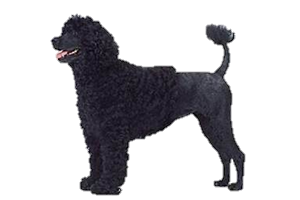Portuguese Water Dog
Cão de Água, Cão de Água Português

Although the Portuguese Water Dog greatly resembles water retrievers they were in fact used by local fishermen. Their tasks included herding fish into waiting nets, retrieving anything from the water, carrying messages between boats, lookouts for schools of fish, and as "fog horns", barking out warnings to other vessels when vision was impaired. Today they are more commonly kept as companions.
Portuguese Water Dog Standards
- American Kennel Club (Working)
- Fédération Cynologique Internationale (Group 8)
- The Kennel Club (Working)
- United Kennel Club (Gun Dog)
- 17-23"
- 35-55 lbs
- medium-sized water dog
- heart shaped, thin ears
- tail does not reach below hock
- thick coat is curly or wavy
any combination of
- black
- brown
- white
History of the Portuguese Water Dog
The Portuguese Water Dog is one of many ancient breeds with an unknown origin. They likely share ancestry with the European retrievers that have been bred to work in water, such as the Barbet (ancestor to the Poodle) and Irish Water Spaniel. However, the Portuguese Water Dog’s talents were not traditionally involved with the hunt. They were first and foremost a fishermen’s dog, an invaluable aid to the boats of Algarve on Portugal’s southern coast. For centuries these dogs were valued so highly that anyone harming them could be punished severely. Unfortunately, with the rise of modern technology these dogs became obsolete and by 1900s were on the verge of extinction. Luckily there were several enthusiasts (led by Vasco Bensaude) that still enjoyed the Portuguese Water Dog and through their efforts they not only survived, but are now recognized by all major kennel clubs.
Related Breeds:
